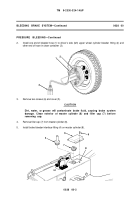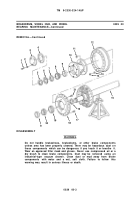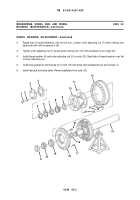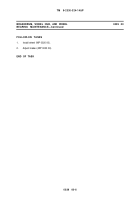TM-9-2330-324-14-P - Page 181 of 350
TM 9-2330-324-14&P
0038 00-3
BLEEDING BRAKE SYSTEM—Continued
0038 00
PRESSURE BLEEDING—Continued
6.
Ensure that valve (10) on brake bleeder quick disconnect (9) is closed, then connect quick
disconnect to brake bleeder interface fitting (4).
7.
If pressure gauge (12) on canister (13) indicates positive pressure, bleed pressure through air
passage valve (14).
8.
Remove top (11) of canister (13). Using a long, blunt object, make sure bladder in canister is
depressed. Bleed pressure through air passage valve (14) while slowly depressing blunt object. Fill
canister with sufficient amount of brake fluid. Replace top.
WARNING
Excessive air pressure could cause injury to personnel or damage to
equipment.
Use care when using air pressure
equipment.
Failure to
follow this warning may result in injury to personnel or damage to
equipment.
9.
Insert 20 psi (138 kPa) of air into canister (13) through air passage valve (14) until gauge (12)
indicates 20 psi (138 kPa). Carefully open driver’s side (left) upper bleeder valve.
10.
Open brake bleeder valve (10) 2 turns.
4
14
12
11
13
10
9
NOTE
Bleeding both wheel cylinders is performed in the same manner. Ensure
both wheel cylinders are bled by starting at the top and then bleeding
the bottom.
Back to Top




















